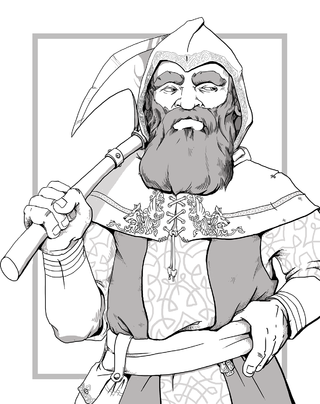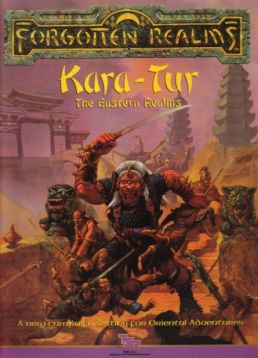Forgotten Realms is a campaign setting for the Dungeons & Dragons (D&D) fantasy role-playing game. Commonly referred to by players and game designers alike as "The Realms", it was created by game designer Ed Greenwood around 1967 as a setting for his childhood stories. Several years later, Greenwood brought the setting to publication for the D&D game as a series of magazine articles, and the first Realms game products were released in 1987. Role-playing game products have been produced for the setting ever since, as have various licensed products including novels, role-playing video game adaptations, comic books, and an upcoming film.
Dragonlance is a shared universe created by Laura and Tracy Hickman, and expanded by Tracy Hickman and Margaret Weis under the direction of TSR, Inc. into a series of fantasy novels. The Hickmans conceived Dragonlance while driving in their car on the way to TSR for a job interview. Tracy Hickman met his future writing partner Margaret Weis at TSR, and they gathered a group of associates to play the Dungeons & Dragons role-playing game. The adventures during that game inspired a series of gaming modules, a series of novels, licensed products such as board games, and lead miniature figures.
Faerûn is a fictional continent and the primary setting of the Dungeons & Dragons world of Forgotten Realms. It is described in detail in several editions of the Forgotten Realms Campaign Setting with the most recent being the 5th edition from Wizards of the Coast, and various locales and aspects are described in more depth in separate campaign setting books. Around a hundred novels and several computer and video games use Faerûn as the setting.
Jeff Grubb is an author who writes novels, short stories, and comics and a computer and role-playing game designer in the fantasy genre. Grubb worked on the Dragonlance campaign setting under Tracy Hickman, and the Forgotten Realms setting with Ed Greenwood. His written works include The Finder's Stone Trilogy, the Spelljammer and Jakandor campaign settings, and contributions to Dragonlance and the computer game Guild Wars Nightfall (2006).
The Underdark is a fictional setting which has appeared in Dungeons & Dragons role-playing campaigns and Dungeons & Dragons-based fiction books, including the Legend of Drizzt series by R. A. Salvatore. It is described as a vast subterranean network of interconnected caverns and tunnels, stretching beneath entire continents and forming an underworld for surface settings. Polygon called it "one of D&D's most well-known realms".

Mystra is a fictional goddess in the Forgotten Realms campaign setting for the Dungeons & Dragons fantasy role-playing game.
Abeir-Toril is the fictional planet that makes up the Forgotten RealmsDungeons & Dragons campaign setting, as well as the Al-Qadim and Maztica campaign settings and the 1st edition version of the Oriental Adventures campaign setting.

The Forgotten Realms Campaign Setting is a role-playing game sourcebook first published by TSR in 1987 for the first edition of the fantasy role-playing game Advanced Dungeons & Dragons that describes the campaign setting of the Forgotten Realms. It contains information on characters, locations and history. Various revised and updated editions have been produced over the years.
Al-Qadim is a campaign setting for the Dungeons & Dragons role-playing game which was developed by Jeff Grubb with Andria Hayday for TSR, Inc., and was first released in 1992. Al-Qadim uses One Thousand and One Nights as a theme and is set in the land of Zakhara, called the Land of Fate. Thematically, the land of Zakhara is a blend of the historical Muslim Caliphates, the stories of legend, and a wealth of Hollywood cinematic history. Zakhara is a peninsula on the continent of Faerûn in the world of Toril, the locale of the Forgotten Realms campaign setting, although Al-Qadim is designed to stand on its own or be added to any existing campaign setting. The basic campaign setting was divided between two game products: Al-Qadim: Arabian Adventures, a sourcebook describing character creation rules, equipment, and spells unique to the setting, and Al-Qadim: Land of Fate, a boxed set describing the land of Zakhara, with separate sourcebooks for the players and the Dungeon Master.
Tiamat is a supremely strong and powerful 5-headed draconic goddess in the Dungeons & Dragons role-playing game. The name is taken from Tiamat, a goddess in ancient Mesopotamian mythology. She is the queen and mother of evil dragons and a member of the default pantheon of Dungeons & Dragons gods. Her symbol is a five-headed dragon.
The Maztica Trilogy is a set of 3 fantasy novels set in the Forgotten Realms campaign setting of the Dungeons & Dragons fantasy role-playing game.

Douglas Niles is a fantasy author and game designer. Niles was one of the creators of the Dragonlance world and the author of the first three Forgotten Realms novels, the Star Frontiers space opera setting and the Top Secret S/I espionage role-playing game.

A dwarf, in the Dungeons & Dragons (D&D) fantasy roleplaying game, is a humanoid race, one of the primary races available for player characters. The idea for the D&D dwarf comes from the dwarves of European mythologies and J. R. R. Tolkien's novel The Lord of the Rings (1954-1955), and has been used in D&D and its predecessor Chainmail since the early 1970s. Variations from the standard dwarf archetype of a short and stout demihuman are commonly called subraces, of which there are more than a dozen across many different rule sets and campaign settings.
The flexibility of the Dungeons & Dragons (D&D) game rules means that Dungeon Masters (DM) are free to create their own fantasy campaign settings. For those who wanted a pre-packaged setting in which to play, TSR, Wizards of the Coast (WotC), and other publishers have created many settings in which D&D games can be based; of these, the Forgotten Realms, an epic fantasy world, has been one of the most successful and critically acclaimed settings. Many campaign settings include standard sword and sorcery environments, while others borrow Asian, Central American, swashbuckling, horror and even space-travel themes.

Monster Mythology, published by TSR in 1992, is a sourcebook about non-human deities that can be used in fantasy role-playing games using the second edition rules for Advanced Dungeons & Dragons (AD&D).

The Ruins of Undermountain is a boxed set for the Forgotten Realms campaign setting for the second edition of the Advanced Dungeons & Dragons fantasy role-playing game. The set was written by Ed Greenwood and published by TSR. It featured box cover art by Brom. and was published in 1991.

Forgotten Realms Adventures is an accessory for the Forgotten Realms campaign setting for the second edition of the Advanced Dungeons & Dragons fantasy role-playing game. The book, with product code TSR 2106, was published in 1990, and was written by Jeff Grubb and Ed Greenwood, with cover art by Clyde Caldwell and interior art by Steven Fabian, Ned Dameron, Larry Elmore, Caldwell, and Jeff Easley.

Kara-Tur: The Eastern Realms is an accessory and campaign setting for the Advanced Dungeons & Dragons fantasy role-playing game.








